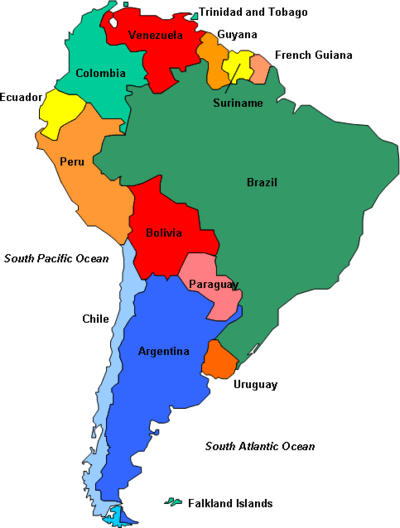
Brazil:
There are many staple ingredients in Briazilian foods. The list is long and as follows, beans, cocunut, dend oil, dried schrimp lemon, dried salted-codfish, rice, and toasted Manioc Meal.
South American Melting Pot: "Brazilian cooking history is in every bite of the country's food. Native Indians developed corn porridge, cassava meal, sweet potatoes, many roots, hearts of palm, many species of game and fish, and the preservation of meats by smoking and drying. In 1533, the Portuguese colonized Brazil. After a lengthy Moorish occupation, Portugal had adapted a variety of North African cooking traditions, among them coffee, dried fruits and pastries. These culinary customs were in turn exported to Brazil, with the twist of being prepared using local ingredients. The largest single influence on Brazilian cuisine came with African slaves. Dende, peppers and coconut milk, staples of West African cooking, became firmly established on the Brazilian palate. During the Nineteenth Century, slavery ended and an independent Brazil became a melting pot for immigrants from all over the world. Waves of new arrivals from Asia, Western and Eastern Europe and the Middle East brought kitchen traditions with them that put a truly eclectic spin on Brazilian cuisine. The nation's multiethnic and multifaceted cooking is always unique and delicious."
Argentina:
"Argentina's high-protein cuisine is sometimes said to resemble European cuisine-particularly Italian, Spanish and French varieties-rather than other Latin American gastronomy. This is partially due to the country's great production of beef, which makes read meat a common ingredient. Grilled meat, called parrilla, and beef ribs are particularly common, but the Argentines do not let too much of the animal go to waste. Argentine cuisine is influenced by waves of European immigration, particularly from Italy. You'll find many Italian restaurants and pizzerias, plus heladerias, or ice-cream parlors, serving Italian cuisine and gelatos . Argentina is known for its beef, and many meals are based on substantial amounts of carne, but other foods are certainly available. Lingering after an evening meal with a sobremesa is a customary time for conversation.Soft drinks and fruit juices are popular. As elsewhere, ask for b jugo puro, or jugo exprimido, for fresh squeezed. Licuados, milky fruit shakes, are popular. Do try maté tea at least once. Other tea is served black with lemon. Ask for té con leche if you want milk in your tea. Hot chocolate is served at breakfast. Coffee is usually an espresso."
Chilie:
"Chilean cuisine tends to the international, plus wonderful seafood that forms the base of many favored dishes. Ethnic restaurants abound in the cities. Vegetarian meals are available. Soft drinks and juices are everywhere. The licuados, fruity milk shakes, are good. Try moté con huesillo , a peach and barley drink. Coffee is usually instant, but espresso is becoming popular. Tea is served black with lemon. Herbal teas, aguitas, are popular after dinner drinks. Try manzanilla, camomile, or a boldo . Chilean wines are superb. Beer, pisco, aguardiente and imported hard liquors are popular. Make sure you try a Pisco Sour, made with egg white, lemon juice and powdered sugar. Try these Recipes from Chile."
Home